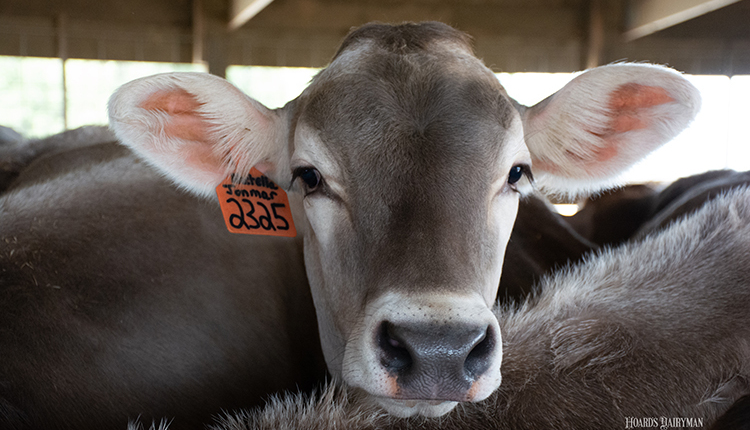
In June, the Council on Dairy Cattle Breeding’s (CDCB) publication of 305-ME (mature equivalent) was discontinued and replaced by 305-AA (average age) as the standardized yield estimate for U.S. dairy cows. This change incorporates current knowledge about the key variables that impact milk yield and improves the accuracy of the estimate.
In August, 305-AA will be implemented in the calculation of genetic evaluations by CDCB. As part of this transition, the 305-AA yield estimates were added to CDCB animal queries in mid-June.
Why does 305-AA matter?
The new descriptor stands for 305-average age. It is the new standardized yield estimation to compare cows of different ages, parities, climates, seasons of calving, and lactation lengths. This management tool estimates a cow’s production for a given lactation, adjusted to 36 months of age and utilizing partial yield measurements captured by milk testing.
This evolution from 305-ME to 305-AA better aligns with current management practices and environmental impacts on production levels. The 305-ME adjustments were updated in 1994 — 30 years ago. Research tells us that genetic selection impacts maturity patterns, and both herd management and the biology of the cow has changed. Dairy producers deserve updated tools for making accurate, fair comparisons among cows. This transition and the new 305-AA are based on a 2023 study by CDCB and USDA’s Animal Genomics and Improvement Laboratory analyzing more than 100 million milk yield records in the national cooperator database.
How will 305-AA affect each breed?
Holsteins will be the least impacted on a breed level as they were the primary data source utilized in the 1994 adjustments. Non-Holstein breeds will see more change, and this is a good thing! With more data now available, adjustments applied are more specific to each breed, rather than broadly calculated from a dataset dominated by Holstein.
The 305-AA adjustments will impact each breed’s Predicted Transmitting Abilities (PTAs) differently. Yield traits will experience the most variation as the traits are specifically revised. There will be potential indirect impacts to a few other traits and direct impacts to Net Merit (NM$) and other indices that rely heavily on yield traits. Test runs of genomic data suggest a small reranking of bulls will take place with this change.
Based on CDCB test runs, the anticipated impacts on genomic PTAs include:
- Ayrshire: Stable with a mild increase in milk, fat, and protein for younger males.
- Brown Swiss: Overall yield PTAs for younger animals will increase slightly, while PTAs of older animals will remain fairly stable.
- Guernsey: Increase for young males with a decrease in milk, fat, and protein PTAs of older males.
- Holstein: Increase in yield PTAs for young males with more stability in older animals.
- Jersey: Noticeable decrease in yield PTAs of younger males, while older males will see an increase.
How is 305-AA different from 305-ME?
Before diving into the changes, note that two variables remain unchanged: standardizing lactations to a 2X milking frequency and the methodology for accounting for previous days open. Variables that have been improved through 305-AA include:
- Season-region: Production is impacted by the geographical region where cows reside and the seasons' weather patterns. These types of impacts are mitigated for comparison’s sake through the standardization of data. Previously, cows were grouped into three geographical regions based on the herd code associated with the production record. In the new 305-AA formula, five climate-based regions are utilized, accounting for cows residing in the hottest to coldest parts of the U.S.
- Breed impact: Previously, breed adjustments were calculated along with the season-region and age-parity adjustments, but now the breed-age-parity and season-region effects are estimated separately as two different multiplicative factors. When computing PTAs over the past 30 years, age-parity adjustments for smaller population breeds were heavily influenced by Holstein data but are now better estimated using their own data from recent years.
- Standardized age: The most visible change in 305-AA is the evolution from ME to AA. Based on industry trends of today, the average cow in the U.S. is 3 years old, meaning that most cows never reach their mature equivalent age outlined in the 1994 report. Without achieving this age, it is not informative to compare cows at a mature equivalent status. Therefore, 305-AA standardizes lactations to 36 months, regardless of breed, to give a more realistic comparison.
Dairy producers rely on a variety of measurements to compare animals of different ages, geographical locations, and breeds. Whether by using NM$ to measure the economic potential of a cow’s genetics, a breed association’s type measurements, or the new 305-AA for yield traits, each is a tool designed to help producers make informed decisions.








